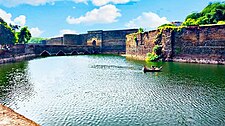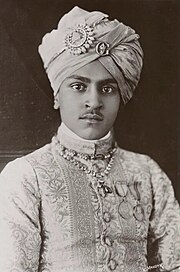Bharatpur State
Bharatpur | |||||||||
|---|---|---|---|---|---|---|---|---|---|
| 1722–1947 | |||||||||
Bharatpur State in the Imperial Gazetteer of India | |||||||||
| Capital | Bharatpur | ||||||||
| Common languages | Braj Hindi | ||||||||
| Government |
| ||||||||
| Maharaja | |||||||||
• 1722–1756 (first) | Badan Singh | ||||||||
• 1929–1947 (last) | Brijendra Singh | ||||||||
| Historical era | Early-modern India | ||||||||
• Established | 18 November 1722 | ||||||||
| 15 August 1947 | |||||||||
| |||||||||
| Today part of | India · Rajasthan | ||||||||







Bharatpur State was a Princely state under British suzerainty that was ruled by the Sinsinwar clan of the Hindu Jats. At the time of reign of king Suraj Mal (1755–1763) revenue of the state was 17,500,000 Gold coin per annum.[2] The major architecture of this state include Lohagarh Fort and Deeg Palace.
Lohagarh Fort is one of the well-known forts located in Bharatpur city of Rajasthan which was built by Maharaja Suraj Mal in 1732 on an artificial island and took eight years to complete. He is famous for building other such forts and palaces in his kingdom. It needed large number of manpower and significant amount of wealth to build such impregnable fort, as the name of the fort itself says-- "Lohagarh", which means, Iron fort (Loha means Iron and Garh means fort).[3] Lohagarh Fort is considered as one of the strongest fort as British forces led by Lord Lake could not capture it in spite of several attacks during the Siege of Bharatpur. Lord Lake made a siege of the fort in 1805 for six weeks but in spite of so many attacks he couldn’t annex it.[4]
Between December 1825 and January 1826, British troops under Lord Combermere initially surrounded the state's capital until on 18 January 1826 its fortress was stormed and captured. After this siege, Bharatpur became princely state under British Raj control.[5]
Deeg Palace is a Palace in Deeg & 32 km from city of Bharatpur in Deeg District in Rajasthan, India. It was built in 1730 [6] by Maharaja Suraj Mal as a luxurious summer resort for the rulers of Bharatpur State.
History
[edit]The formation of the state of Bharatpur was a result of revolts by the Jats living in the region around Delhi, Agra, and Mathura against the imperial Mughals.[7][8] Gokula, a local Jat zamindar of Tilpat, led the first of such revolts in 1669. Even though the Jats were defeated and Gokula was executed, the movement was not completely crushed and discontent continued to simmer.[7] In 1685, there was a second uprising of the Jats under RajaRam of Sinsini, that was better organized this time and used guerrilla warfare, combining it with loot and plunder.[7] Now Aurangzeb approached the Kachhwaha ruler Bishan Singh to crush the uprising and appointed him as the faujdar of Mathura, granting him the entire area in zamindari. Conflict between Jats and Rajputs for zamindari rights also complicated the issue, with Jats primarily being landowners, whereas the Rajputs were primarily revenue collectors.[7] The Jats put up a stiff resistance but by 1691, RajaRam Sinsini and his successor Churaman were compelled to submit to the Imperial Mughals. However unrest among Jats continued and later on in the beginning of the 18th century, Churaman, taking advantage of the Mughal civil wars, was able to oust the Rajputs from the area and establish an independent state where Jat chiefs formed the ruling class.[7] Rajaram who also exhumed and burned the remains of Akbar is known for setting up a small fort at Sinsini. It was the key foundation of this kingdom.[9][10]
The most prominent ruler of Bharatpur was Maharaja Suraj Mal. He captured the important Mughal city of Agra on 12 June 1761.[11] He also melted the two silver doors of the famous Mughal monument Taj Mahal.[12] Agra remained in the possession of Bharatpur rulers till 1774.[13] After Maharaja Suraj Mal's death, Maharaja Jawahar Singh, Maharaja Ratan Singh and Maharaja Kehri Singh (minor) under resident ship of Maharaja Nawal Singh ruled over Agra Fort.[citation needed]
The Jats were later defeated by the Mughal army under the command of Mirza Najaf Khan in 1774. Mirza Najaf Khan re-captured most of the Jat lands including Agra and Aligarh.[14]
In 1805, war between the British and the Holkars broke out. Maharaja Ranjit Singh of Bharatpur agreed to help the Holkar and the two Maharajas fell back to the Bharatpur fort. The British surrounded the fort and after three months, Ranjit Singh agreed to peace and signed a treaty with the British, thus becoming a princely state.[15] Maharaja Jaswant Singh of Bharatpur provided great support for the British during the Indian Rebellion of 1857 and this aid was greatly acknowledged by the British. The young Maharaja was made a G.C.S.I and his personal gun salute was increased.[16]
In August 1947, the state of Bharatpur acceded to the newly independent Dominion of India. In 1948, it became part of the Matsya Union and in 1949, it was absorbed into the state of Rajasthan. Members of the ruling family continue to be active in national and regional affairs. Several members of the family have served as members of parliament and in the state legislature.[17]
Expansion and decline
[edit]In the 1760s, the Kingdom of Bharatpur reached its zenith and covered present day capital Delhi and district of Agra, Aligarh, Alwar, Bharatpur, Bulandshahr, Dholpur, Etah, Etawa, Faridabad, Firozabad, Ghaziabad, Gurgaon, Hathras, Jhajjar, Kanpur, Mainpuri, Mathura, Mewat, Meerut, Muzaffarnagar, Palwal, Rewari, and Rohtak.[18] The areas under the control of Jats broadly included parts of modern eastern Rajasthan, southern Haryana, western Uttar Pradesh and Delhi.

The Jats were later defeated by the Mughal army under the command of Mirza Najaf Khan in 1774. Mirza Najaf Khan re-captured most of the Jat lands including Agra and Aligarh.[14]
Military power
[edit]The Kingdom during Jawahar Singh's time had a large army of 25,000 Infantry, 15,000 Cavalry and 300 pieces of cannons with addition to the troops stationed at his forts.[19]
See also
[edit]References
[edit]- ^ Sunderlal, Pandit (2018). How India Lost Her Freedom. SAGE Publishing. p. 500. ISBN 9789352806423.
- ^ Sen, Sailendra Nath (2010). An Advanced History of Modern India. Macmillan. p. 420. ISBN 978-0-230-32885-3.
- ^ "Lohagarh Fort". 10 February 2024.
- ^ "Lohagarh Fort: कोई नहीं जीत पाया ये किला, 13 बार हमले के बाद अंग्रेज भी हो गए थे असफल". 5 February 2024.
- ^ "Siege of Bharatpur, 1825-1826". 5 May 2024.
- ^ History of Deeg Palace in Bharatpur
- ^ a b c d e Chandra, Satish (1990). Medieval India. India: National Council for Educational Research and Training. pp. Chapter 18 p. 295, 296.
- ^ History of jats state during 17th century
- ^ Kunj Bihari Lal Gupta. The Evolution of the Administration of the former Bharatpur State. Vidya Bhawan Publishers, Jaipur, 1959.
- ^ Tony McClenaghan. Indian Princely Medals: A record of the Orders, Decorations and Medals of the Indian Princely States. Lancer Publications, Spantech & Lancer, New Delhi, 1996.
- ^ Bhatia, O. P. Singh (1968). History of India, from 1707 to 1856. Surjeet Book Depot. p. 536.
- ^ "Taj Mahal". MANAS. Retrieved 25 May 2021.
- ^ Prakash Chandra Chandawat: Maharaja Suraj Mal aur unka yug, Jaypal Agencies Agra, 1982, Pages 197–200
- ^ a b "Najafgarh: A Kingmaker in the Capital". Live History India. Retrieved 25 May 2021.
- ^ Nandakumar, Sanish (2020). Rise and Fall of The Maratha Empire 1750-1818. Notion Press. p. 86. ISBN 978-1-647-83961-1.
- ^ "Princely States of British India - Card Game". www.Heritageshaala.com.
- ^ "Vishvendra Singh Bharatpur".
- ^ Chaudhuri, J. N. (1977). "Disruption of the Mughal Empire: The Jats". In Majumdar, R. C. (ed.). The History and Culture of the Indian People. Vol. 8: The Maratha Supremacy. Bharatiya Vidya Bhavan. p. 157. OCLC 1067771105. Retrieved 20 December 2019.
- ^ Sarkar, Jadunath (1994). A History of Jaipur: C. 1503-1938. Orient Blackswan. p. 253. ISBN 978-81-250-0333-5.
Notes
[edit]- Imperial Gazetteer of India Vol 8, P-73 Bharatpur State
- R. C. Majumdar, H.C. Raychaudhury, Kalikaranjan Datta: An Advanced History of India, fourth edition, 1978, ISBN 0-333-90298-X, p. 535-36
- Attribution
This article incorporates text from a publication now in the public domain: Chisholm, Hugh, ed. (1911). "Bharatpur". Encyclopædia Britannica (11th ed.). Cambridge University Press.
External links
[edit]- Bharatpur State at Britannica
 Media related to Bharatpur State at Wikimedia Commons
Media related to Bharatpur State at Wikimedia Commons
- History of Bharatpur, Rajasthan
- Princely states of Rajasthan
- States under the Rajputana Agency
- States and territories established in the 17th century
- States and territories disestablished in 1947
- 1722 establishments in India
- 1947 disestablishments in British India
- 1948 disestablishments in India
- Gun salute princely states




